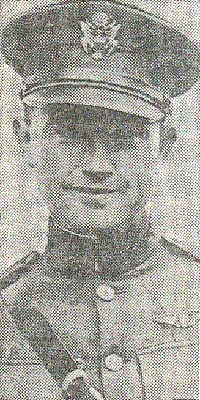Lowell H. Smith
 |
Lowell Smith was born in Santa Barbara, CA October 8, 1892.
He graduated from San Fernando College and the Military School
of Aeronautics at the University of California in 1917. He
is among the more illustrious pilots and passengers to land at
Tucson.
He signed the Davis-Monthan Register once on February
20, 1926 flying a Douglas O-2, carrying one unidentified passenger. He
had landed at the Airfield earlier, however, flying the Douglas World Cruiser (DWC) "Chicago". He was commander
of the Around-the-World Flight DWC fleet in 1924. The Register was not on the Airfield until 1925, so there is no signature to document his 1924 visit.
He held sixteen world
records in military aircraft for speed and endurance and
was awarded the Mackay Trophy in 1924 for his leadership
of the World
Flight. See the link for additional images of him. His co-pilot and mechanic on the "Chicago" was Leslie Arnold.
He enlisted as a private in April 1917 in the Aviation Section
of the Signal Corps, qualified as a pilot in October of that
year and was commissioned First Lieutenant in December. He
was ordered to England during WWI, receiving intensive training
in Handley-Page aircraft. He was promoted to captain in October
1918.
Back in the U.S. after the war he distinguished himself
between 1920-21 in carrying out the work of airplane forest
fire patrol throughout California, Washington and Oregon.
He saved the government and private forest holdings millions
of dollars.
He gained fame in 1923 when he and John Richter, another
Army pilot and signer of the Davis-Monthan Register, broke
eight world aviation endurance records on August 27 & 28
over Rockwell Field, San Diego, CA. The two made a flight
of over 37 hours during which they refueled their plane in
the air. Regardless of the endurance record, this was the
VERY FIRST air-to-air refueling event. All contemporary refueling
from airborne tankers dates from August 1923. See this link for
unique images of that event on this site. A description of the flight is in Richard Smith's book, Seventy-Five Years of Inflight Refueling: Highlights, 1923-1998 in the REFERENCES.
During the late 1920s he spent three years on duty in the
Hawaiian Islands. It was there that The New York Times of
July 12, 1928 reported in headline, "Capt. L.H. Smith Loses
Finger in Propeller". Indeed, he had flown a Fokker monoplane
to Hilo on an inspection tour and was preparing to take off
for Wheeler Field a little before 10AM when he signaled
mechanics by wave of his hand to swing the tail of the airplane
further around. During the wave his fingers passed through
the propeller's arc and it removed the middle finger of his
right hand and lacerated the index finger.
He stepped from the cockpit saying, "Shut her off, Sergeant,
please." A tourniquet was applied, he went to see a physician,
and Smith declared, "It's nothing much, we will take off
for Oahu at noon." This he did.
Besides his refueling endurance
records and the World Flight, which have good coverage on
the Web, he developed in the 1930s the entire procedure for
massed airborne troop landings. He piloted the first plane
to participate in mass parachuting. Click this PDF
download (152KB) to see what he wore
and what he carried.
That there is honor among officers is illustrated by this
kind exchange (PDF
245KB) of letters by Smith on behalf of Capt. Oakley
G. Kelly. Clearly, these two pilots shared a spectrum
of similar airborne (and probably ground-based) experiences, and these simple and courteous
letters reflect the respect gained therefrom.
During WWII Smith trained heavy bombardment crews at the
Davis-Monthan Airfield, which had been converted, in 1940 to
a military air base. He also commanded the base during that
time. Ironically, after all his aviation exploits, Col. Lowell
Smith died November 4, 1945 at age 53 after being injured
in a fall from a horse just outside Tucson.
---o0o---
An interesting part of his posthumous "career" is that,
during 1953 to the early 1960s, there was a swirl of correspondence
between Smith's widow, Madelaine, and various military and
political chiefs. This correspondence is preserved in Smith's
NASM dossier, and it attends to the traditional listing of
Maj. Frederick Martin as "commander" of the World Flight.
Martin and his mechanic, Alva Harvey (who also signed the
Register), crashed in Alaska early in the flight and Smith
was assigned the command to continue around the world. His
assignment never seemed to get into the official record,
though, and Mrs. Smith was out to get the record changed.
Madelaine was, to say the least, outspoken
in her lobbying to have her husband recognized as THE commander
of the World Flight, citing the fact that he was, "...in
command for 23,973 miles of the 26,345 mile flight." And
that, "...Martin -- 2,372 miles." It is comically
frustrating to read the exchange of letters between her and
Hoyt Vandenberg, Nathan Twining and Arizona Senator Barry
Goldwater (all three, interestingly, signers of the Davis-Monthan
Register). While it is common knowledge that Smith was the
commander, the official record remains with Martin in that role, despite Madelaine's
efforts.
---o0o---
Dossier 2.2.4
UPLOADED: 01/16/07 REVISED: 02/09/08, 03/02/08, 12/30/09
|


